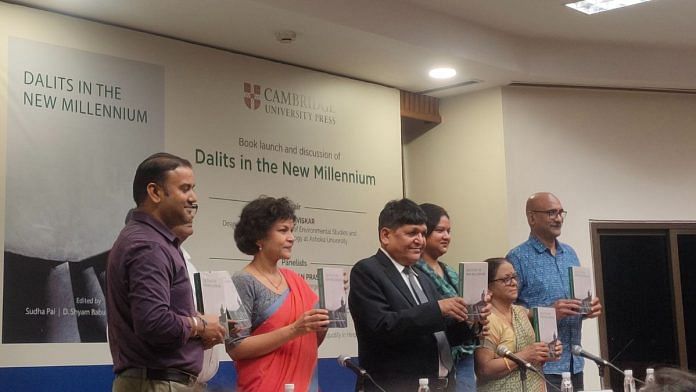Dalits in Uttar Pradesh turned their back on Mayawati’s Bahujan Samaj Party, and with its collapse there’s a new structure of political power play in India’s largest state. Smaller sub-castes are voting for Yogi Adityanath and Narendra Modi, emphasising their separate social identity and aspiring to be a part of the guarded Hindu Right, said professor and scholar Sudha Pai at the launch of Dalits in the New Millennium, which she edited along with D. Shyam Babu and Rahul Verma.
The collection of 24 essays is part of a new emerging scholarship to understand and explore the Dalit identity in Modi’s India—their politics, protests and persecution. Pai sees the rising atrocities as a sign that society has moved from “ritual untouchability to social jealousy”.
There’s visibly increasing participation from the community—one that is accompanied by a BJP-Modi shift when it comes to electoral choices. Since 2009, the percentage of Dalits voting for the Bharatiya Janata Party (BJP) has been climbing. But shift is not without friction.
An essay by Pranav Gupta and Rahul Verma breaks down the BJP’s growing clout by its ability to win more reserved seats. Of the 84 reserved seats in the country in the 2019 Lok Sabha elections, 46 were won by BJP.
“This has created division between the Ambedkarites and the Hindutvawadis,” said Pai. Cultural mobilisation and welfare initiatives by the BJP to expand its Hindu support base has resulted in greater acceptance among Dalits. The Hindutvawadi Dalits, for example, have embraced the Bhakti era religious legacy of Ravidas, while the Ambedkarites view Ambedkar as the inheritor of the legacy of the Buddha.
These changes are not limited to the politics and vote banks.
“With the rise of the Hindutva effect in India, the modern Dalit also fights for separate social identities to match the Hindutva model of identity. The nature that a lot of people from the community follow is adaptive,” said Verma who was at the launch at India International Centre (IIC).
Also read: 17 years since Khairlanji massacre, Modi govt has a Dalit opportunity
Existing anxieties about identity
But the image of the strong, politically active Dalit fighting for a voice and representation, is countered by fear, rising atrocities, and young adults moving away from identity politics.
“Dalit women are pulling back from agricultural fields as they are still scared of the farm owners,” said columnist and scholar Chandra Bhan Prasad, who was part of the panel discussion. He pointed out that Dalit parents are still sceptical about sending their children to media schools, law schools, even for science and technology.
“This scepticism affects the representation of the community in the modern world today,” he said.
Despite economic development, approximately 80 per cent of Dalits live in rural areas where the majority of them either work in sanitation or as agricultural labourers. They still suffer from low income and get harassed by landlords.
The yearning to be part of the mainstream and forge ahead on equal footing has resulted in a lot of the younger generation of Dalits running away from their identity, said panellist Aditi Narayani Paswan, a sociology professor at Delhi University. They prefer accepting caste neutral surnames so they are not identified as Dalits.
This was brought out in the fifth episode of Made in Heaven Season 2, when Pallavi Menke’s brother questioned her on her decision to ‘come out’ as a Dalit without understanding the ramifications it had on him.
The Dalit middle class have to still experience society’s resistance to their social and economic mobility every day.
And it follows them everywhere—from the elite ivy league halls of Harvard University to their workplaces in the UK, Australia and other parts of the world. Around 25 per cent of Dalits in the US said they faced verbal or physical assault, according to research by Equality Labs.
None of the essays, however, explore gender and the Dalit identity from the female perspective in depth, but it came up for discussion at launch.
In cities and liberal social circles, there is still inhibition among men in the upper caste when it comes to dating Dalit women.
“There is no research on how many times a dark-skin Dalit woman is swiped right on these dating apps,” said Aditi Narayani Paswan.
(Edited by Anurag Chaubey)



